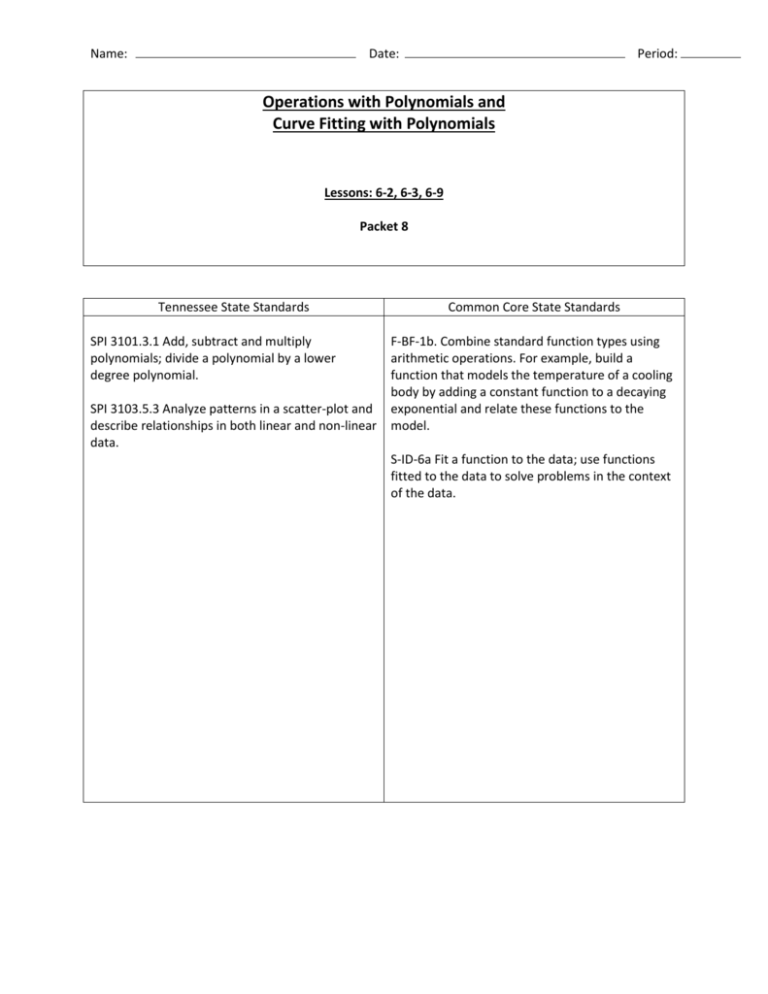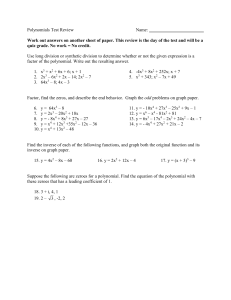Dividing Polynomials with Synthetic Division
advertisement

Name: Date: Period: Operations with Polynomials and Curve Fitting with Polynomials Lessons: 6-2, 6-3, 6-9 Packet 8 Tennessee State Standards SPI 3101.3.1 Add, subtract and multiply polynomials; divide a polynomial by a lower degree polynomial. SPI 3103.5.3 Analyze patterns in a scatter-plot and describe relationships in both linear and non-linear data. Common Core State Standards F-BF-1b. Combine standard function types using arithmetic operations. For example, build a function that models the temperature of a cooling body by adding a constant function to a decaying exponential and relate these functions to the model. S-ID-6a Fit a function to the data; use functions fitted to the data to solve problems in the context of the data. Name: Date: Lesson 6-2 Multiplying Polynomials Period: p.1 Warm-Up: Multiply Coefficients and Add Exponents of Like Bases. x(x3) 2(5x3) xy(7x2) 3x2(-x5) Monomial times a Polynomial 4y2(y2 + 3) fg(f4 + 2f3g – 3f2g2 + fg3) Binomial times a Binomial (FOIL) (x + 3) (x – 5) (x – 4) (x + 4) Polynomial times a Polynomial (x – 3)(2 – 5x + x2) (y2 – 7y + 5)(y2 – y – 3) Name: Lesson 6-2 Date: Multiplying Polynomials Period: p.2 Binomial Expansion ( x + y)2 (a + 2b)3 Part B: Homework 1. 7x(2x + 3) 2. (x + 1)4 3. (x – 1)(2x2 + 3) 4. (x – 6)(x4 – 2x3 + 1) 5. 2xy(3y2 – xy + 7) 6. (x4 + x2y)(x3 + y2) Name: Lesson 6-3 Date: Synthetic Division Dividing Polynomials with Synthetic Division (2x2 + 7x + 9) ÷ (x + 2) (x2 + 5x + 6) ÷ (x + 1) (x4 – 7x3 + 9x2 – 22x + 25) ÷ ( x – 6) Period: p.3 Name: Lesson 6-3 Date: Synthetic Division Period: p.4 Part A: Guided Practice (x4 – 2x3 + 3x + 1) ÷ (x – 3) (3x2 + 9x – 2) ÷ (3x – 1) Name: Lesson 6-3 Date: Dividing Polynomials Period: p.5 Part B: Homework (Use Synthetic Division) 1. (x2 – 18x + 14) ÷ (x – 1) 2. (3x3 – 11x2 – 56x – 48) ÷ (3x + 4) 3. (x3 – 2x – 8) ÷ (x – 2) 4. (3x3 + 5x2 + 2x – 12) ÷ (x + 3) Name: Date: Adding/Subtracting Polynomials Period: p. 6 When adding polynomials, simply ______________ __________ _____________. 1. (x3 – 2x2 + 4x – 2) + (x2 + 3x + 5) 2. (3x4 + x2 – 5x + 8) + (-5x4 + 3x3 + 7x2 – 2x – 1) When subtracting polynomials, _________________ the subtraction sign and then __________________ _____________ _____________. 1. (3x4 + 5x2 – 4x + 1) – (2x4 – x3 + 2x2 + 3x – 2) 2. (-2x3 + 8x2 + x – 3) – (5x3 + 6x2 – 4x + 3) Name: Date: Adding/Subtracting Polynomials Part B: Homework 1. (2x2 + 6x + 5) + (3x2 - 2x – 1) 2. (x4 + 2x3 – 4x + 6) + (-3x4 + 4x3 +1) 3. (4x3 + 2x2 – 4x + 1) – (x3 – 4x2 + 5x + 5) 4. (4x3 – 4x2 + 3x – 1) + (2x2 + x – 3) 5. (-3x2 + 2x – 4) – (6x2 – 3x – 3) Period: p. 7 Name: Date: Lesson 6-9 Period: Curve Fitting p. 8 To create a mathematical model for data, you will need to figure out what type of function is ______________________________. Finite ________________ can be used to identify the __________________ of any polynomial data. This chart will help you decide which type of function to use: Function Type Linear Quadratic Cubic Quartic Quintic Constant Finite Differences Degree Example: x y 2 -2 5 0 8 2 11 4 14 6 17 8 1. Find the differences in the y-values. x y -6 -30 -4 15 -2 30 0 34 2 41 4 60 Name: Date: Lesson 6-9 Period: Curve Fitting p.9 2. Find the differences in the y-values. X y -2 -10 -1 -4 0 -1.4 3. Find the differences in the y-values. x 4 6 8 Y -2 -4.3 8.3 1 0 10 10.5 2 2.4 12 11.4 3 8 14 11.5 Once you know which type of function to use, use the calculator to write a function. 1. Enter data on L1 and L2 (Stat Edit) 2. Go to Stat,Calc, and choose the appropriate type. 3. Enter- now put the function’s equation together. 1. The table shows the population of a city from 1960 to 2000. Write a polynomial function for the data. Year 1960 1970 1980 1990 2000 Population 4,267 5,185 6,166 7,830 10,812 (thousands) Name: Date: Lesson 6-9 Curve Fitting Period: p.10 2. The table below shows the opening value of a stock on the first day of trading in various years. Use a polynomial model to estimate the value of the first day of trading in 2000. Year 1994 1995 1996 1997 1998 1999 Price ($) 683 652 948 1306 863 901 Type of Model: ____________________________________ Equation: _________________________________________ Estimate the value of the first day of trading in 2000: ______ 3. The table below shows the number of infected patients at various stages of a flu outbreak. Use a polynomial model to estimate the number of infected patients after 120 hours. Time (h) 12 24 48 96 144 240 Patients 21 301 679 973 562 320 Type of Model: _______________________________ Equation: ____________________________________ Estimate the number of infected patients after 120 hours: _________ Name: Date: Lesson 6-9 Curve Fitting Period: p.11 Part B: Homework 1. Use finite differences to determine the degree of the polynomial that best describes the data. x 8 10 12 14 16 18 y 7.2 1.2 -8.3 -19.1 -29 -35.8 2. Write a polynomial function using the given data. x y 5 30 10 34 15 36 20 36 25 34 Type of model: Equation: 3. The table shows the population of a bacteria colony over time. Write a polynomial function for the data and use it to estimate the number of bacteria after 7 hours. Time (h) 1 2 3 4 5 Bacteria 44 112 252 515 949 Type of model: Equation: Estimate the number of bacteria after 7 hours. 4. Use finite differences to determine the degree of the polynomial that best describes the data. x y -2 -3 -1 1 0 4.3 1 6.9 2 8.8 3 10








